Introduction
Before the movie “Back to the Future” had been thought of, Honda introduced its new model for 1978 as “First to the Future”. This was a new model that had big shoes to fill. Its predecessor, the Honda CB550 had been a simply brilliant motorcycle with good handling and balance. So the new motorcycle from Honda for 1978 needed to be not just a good bike, it needed to be a great bike.
The new bike from Honda for 1978 came from the mind of Shoichiro Irimajiri, the designer responsible for the Honda GL1000 and the jaw dropping six cylinder Honda CBX. But his new design for 1978 did not precipitate the same wide eyed wonder as the CBX when reviewers first caught sight of it. It looked sort of like a cross between a Honda and a Moto Guzzi and the appearance initially left a lot of reviewers cold, one described its engine saying “It looks like an air compressor.”. This was not going to be a case of love at first sight.
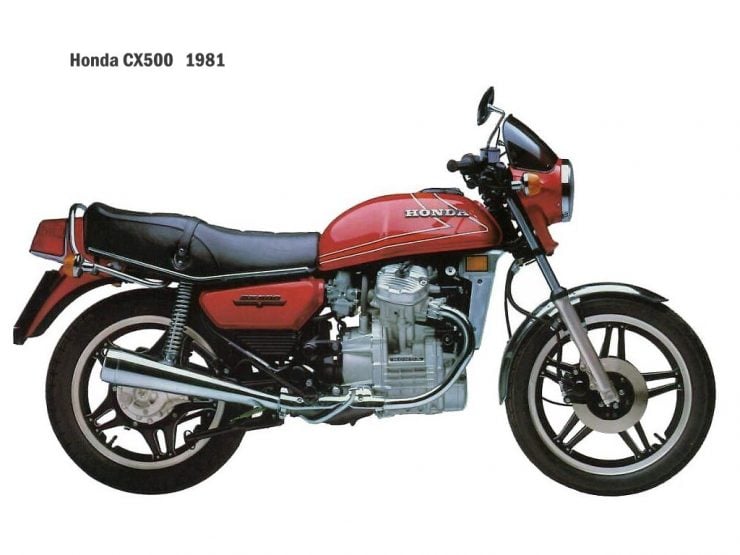
The CX500
The engine is the heart of a motorcycle and it does much to define the character of the bike. Shoichiro Irimajiri’s engine for the CX500 was a 497cc 80° V-twin producing 48hp @ 9,000rpm and capable of driving the bike to 106mph. This engine was not set laterally in the frame however as in a Harley-Davidson but longitudinally as in the Italian Moto Guzzi. The 80° V angle made the engine narrower than on the Moto Guzzi but also made balancing the engine a bit more difficult.
To keep the width of the engine as narrow as possible the cylinder heads were twisted at 22° to tuck the carburettors inwards away from the rider’s legs and to allow the exhaust to sit out to clear the radiator. This was a liquid cooled V-twin engine. In order to provide that 22° twist to the cylinder heads it was not possible to use the overhead camshafts that Honda tended to favor so the engine was made as a double valve OHV engine with a camshaft sitting between the cylinders acting on short push-rods. This also helped keep the height of the engine a bit lower and eliminated the need for cam chains to drive overhead cams for each cylinder. The rockers were forked so that each rocker could actuate two valves. The compression ratio was 10.0:1 and the engine was capable of a 9,650rpm red-line.
Shoichiro Irimajiri decided to connect the longitudinally mounted V-twin’s transmission to a shaft final drive similar to that used by Moto Guzzi but he wanted to keep the length of the engine and transmission as short as possible so he mounted the gearbox underneath the engine and slightly to the right. To counter the tendency for a longitudinally mounted V-twin engine to impart a twisting effect on the bike (as one experiences on older model Moto Guzzi if one blips the throttle) Shoichiro Irimajiri made the clutch and five speed transmission to rotate in the opposite direction to the engine so the rotational forces tended to balance each other out to some extent. The shaft drive was an enclosed splined unit connected to the rear wheel via a bevel gear enclosed in an oil bath attached via a cush-drive to dampen out shocks and vibrations in the drive line. With the engine mounted directly over the transmission the length of the engine and transmission unit was kept short but it was also tall and this was to impart a distinct character to the motorcycle.
The frame of the CX500 featured a quite thick spine with the engine/transmission unit acting as a stressed member. Front forks on the early model were hydraulic with dual rear coil spring over telescopic shock absorbers at the rear. These would be upgraded to air assisted front forks with Honda’s Pro-link mono-shock rear suspension on later models. With its quite large 4.9 US gallon fuel tank and thick spine frame the CX500 was quite a heavy motorcycle tipping the scales at 441 lbs (dry).
It was when reviewers got on the bike and took it for a ride that many of the skeptics were won over. The short length and carefully designed suspension ensured a bike with great handling. One reviewer said of the CX500’s steering that it was “… wonderfully neutral and light, it seems almost to sense your desire to make slight course corrections.”
Brakes for the first model CX500 shipped to the US market were a single front disc with a drum brake at the rear. Wheels for this model were Comstar, 19” front and 18” rear. The CX500 was the first production motorcycle to be fitted with tubeless tires. This bike was generally known as the CX500 “Standard” except in the Australian market for 1980-1982 where it was called the CX500 Shadow.
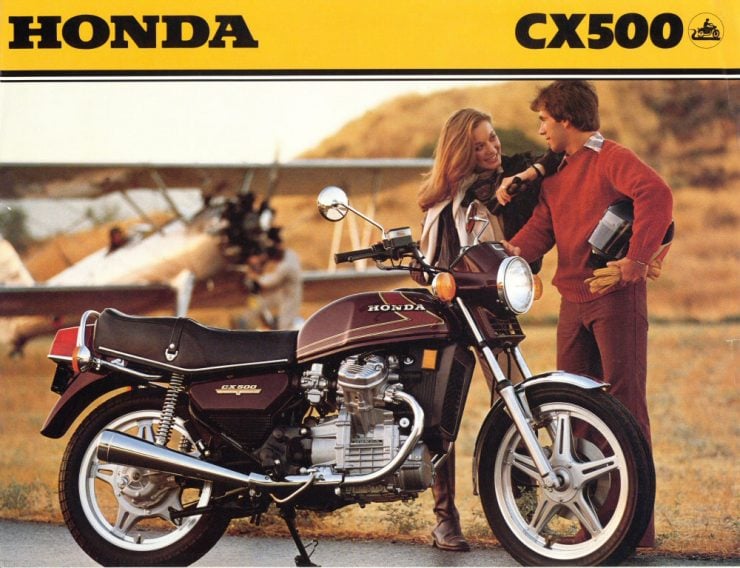
CX500 Custom
A year after the introduction of the CX500 Honda introduced a new variant, the CX500 Custom. This bike had a smaller narrower fuel tank and “buckhorn” handlebars. The front turn signal lights were moved from the front fairing to being mounted lower down on the front forks.
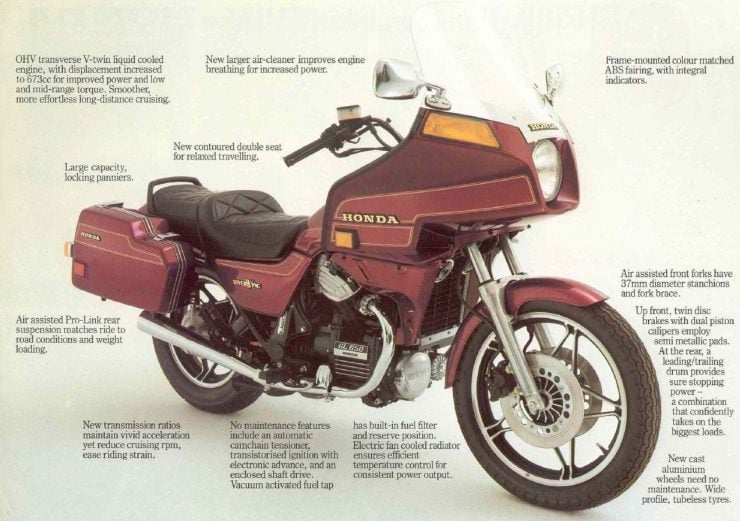
CX500 Deluxe
The CX500 Deluxe was also introduced in 1979 and had only slight differences to the original CX500. Those differences were limited to removal of the CX500’s fairing and the consequent changes to the headlight and instrumentation. The original fairing of the first model CX500 had been thought to look a bit peculiar and had earned the bike the nickname “plastic maggot”. Perhaps Honda dealers heard about that and decided it was not as complimentary as they would prefer so Honda made the minor changes to eliminate the negative connotations. The wheel color was changed from silver alloy to black reversed and the wheel sizes were changed to 19” front and 16” rear. The CX500 Custom and CX500 Deluxe models proved so popular that the CX500 standard was withdrawn from production in 1980.
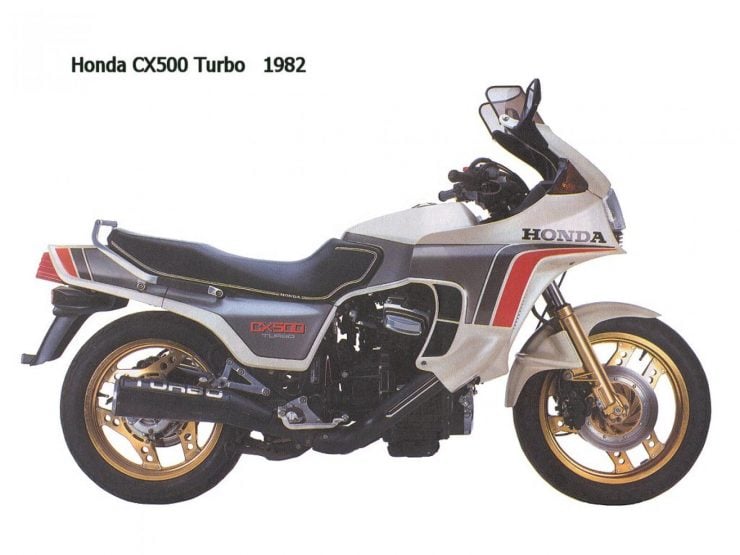
GL500 Silver Wing and GL650 Silver Wing
The GL500 Silver Wing was introduced in 1981 and was created as a touring variant of the CX500 and was based on the CX500 engine with the new transistorized ignition system, and drive train. There were two models of the GL500 Silver Wing, one a bare bones bike and the other with a front fairing, hard saddle bags and a trunk which was interchangeable with the rear seat. So the bike was a one seater only with the trunk fitted. In 1983 the GL500 was superseded by the GL650 with the new 674cc engine which produced 60hp.
The GL650 also had the gear ratios changed to provide taller gearing for highway cruising resulting in improved highway fuel consumption by comparison with its smaller capacity but shorter geared sibling. The GL650 Silver Wing Interstate was only produced for the 1983 model year. Brakes for the GL500 and GL650 were the dual front discs and the fuel tank capacity was 4.6 US gallons (17.5 liters). Dry weight of these bikes was 478 lbs and the fact that these bikes were quite heavy for their capacity did not aid their sales.
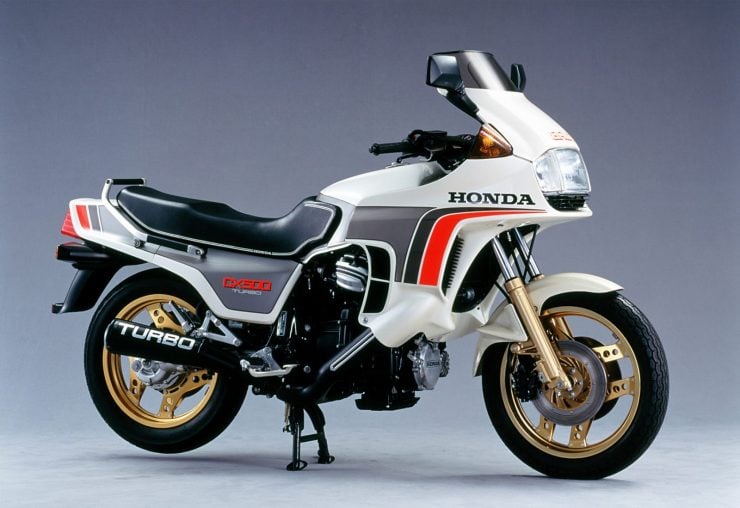
CX500EC Sports
By 1982 the dealer networks had experienced both positive and negative feedback on the original CX500 series bikes and with that information fed back to Honda two new models were introduced for 1982 that had some significant improvements and which also shared some common parts, the first of these was the CX500EC Sports. The CX500EC Sports suspension was improved by fitting of air pre-load assisted anti-dive front forks and an air pre-load assisted Pro-Link mono-shock rear. The Honda anti-dive system was called Torque Reactive Anti-dive Control, abbreviated to “TRAC”. Front and rear wheels were of 18” diameter and were Comstars, but of a different style to previous models. Tires were now a 100–90H18 for the front and a 120–80H18 at the rear.
Brakes were also given a significant upgrade with twin front discs with twin pot calipers at the front and a single disc with twin pot calipers at the rear. The styling of the CX500EC was modernized with a front fairing containing a rectangular headlight that provided better illumination, a large fuel tank, and re-styled side panels and seat. One of the more significant improvements that appeared on this model was the automatic cam chain tensioner. The early model CX500 bikes had manual cam chain adjustment and this provided a universally bad experience for owners and had given the CX500 a bit of bad name as a consequence.
The automatic cam chain tensioner was arguably a feature that should have been incorporated into the engine at the very beginning but it took Honda time to realize the significance of the problem and to create a bulletproof engineering solution to it. The automatic cam chain tensioner was able to be retro-fitted to the earlier model CX500 bikes and most if not all received that modification. There were also more subtle engineering improvements made to the engine, one being the reduction of valve clearances indicative of more precision in manufacturing and fitting. The engine of the CX500EC Sports was also given some cosmetic changes with black painted stripes on the valve covers and satin alloy flat areas on the engine.
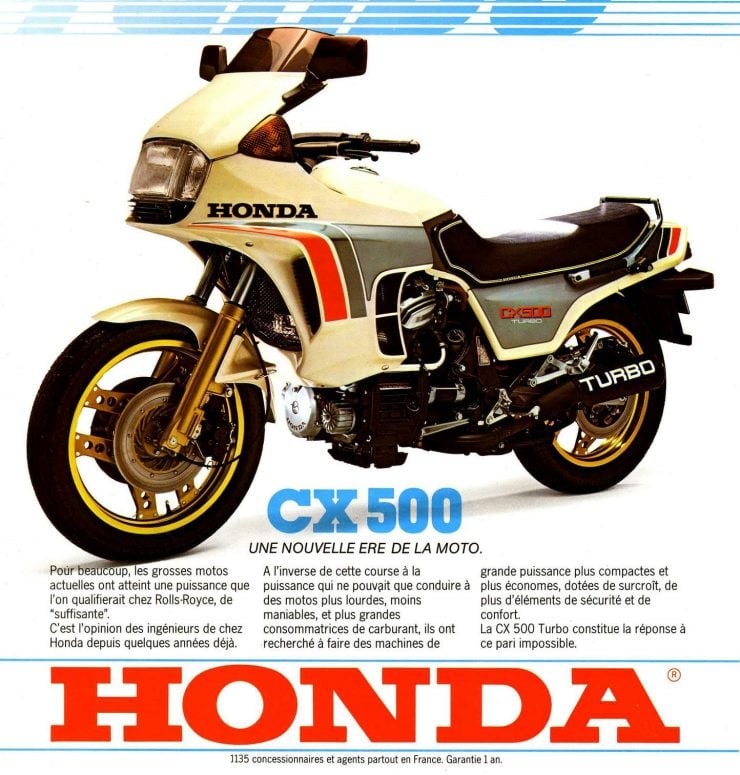
CX500 Turbo
The other significant CX500 model released in 1982 was the CX500 Turbo. This bike brought all the improvements of the CX500EC Sports with the performance boost of a turbocharged engine putting out 82hp, almost double the power of the first model. This power increase was not only attributable to the 19psi turbo boost but also to the programed fuel injection system which incorporated a separate ignition system with built in fail safe redundancy. In almost doubling the peak power of the engine the bottom end needed some beefing up which was provided by fitting the crankshaft for the new 674cc engine as used in the CX650 series motorcycles.
CX650C
1983 saw the introduction of the CX650C (also called the CX650 Custom). This model was only produced for one year but it is one of the more interesting and attractive of the CX500 and CX650 series motorcycles. The front forks of the CX650C were raked in semi chopper style with high handlebars and upright riding position making the bike suitable for long distance cruising as well as being a great daily ride. This motorcycle was designed for the US market.
The fuel tank was of the teardrop shape, front brake was a single disc with twin pot calipers and a disc at the rear also. The low seat offered a comfortable riding position especially for those of us who are not 6′ tall and the exhaust systems were low mounted truncated cone types. These are a very stylish and practical motorcycle. The CX650C was a cruising motorcycle that filled the same market niche as Honda’s 750 Shadow and so Honda decided to keep the 750 Shadow in production and phase out the CX650C.

CX650ED
The CX650ED is also known as the Eurosport and was aimed at the British and European markets with the ability to be marketed in culturally similar countries such as Australia, New Zealand, and Canada. The CX650ED featured the TRAC anti-dive forks, Pro-Link rear suspension, and front and rear disc brakes with twin-pot calipers. These bikes feature a modest front fairing with windshield, a fairly upright riding position and clean European styling.
CX650T
In 1983 the CX500 Turbo gave way to the turbocharged CX650T. This bike with its greater engine capacity allowed some useful changes over the CX500 Turbo. The 674cc engine’s compression ratio was increased slightly over that used in the CX500 Turbo and the turbo boost pressure was lowered to even out the engine’s power especially as the turbocharger boost kicked in, making for a smoother power delivery. The engine’s power was now 97hp.
The engine’s fuel injection system was also extensively changed for best results with the turbocharger. This bike featured the twin front and single rear disc brakes of the sports models with the air pre-load front forks with anti-dive TRAC and also featured an adjustable rear suspension damping control in addition to the air pre-load mechanism. The CX650T was an expensive high performance motorcycle although it was subject to some cost cutting by Honda in changing from fiberglass fairings and covers to ABS plastic. Perhaps Honda reasoned that if ABS is used in firearms manufacture then it must be “bulletproof” enough for a Honda motorcycle fairing.
Other Minor Models
There were 400cc models of the CX and GL bikes made for the Japanese domestic market and Europe where license costs for smaller capacity bikes are lower. These were called the CX400 and GL400. Also, for the Japanese domestic market the GL650 SilverWing Interstate was named the Limited Edition GL700 Wing Interstate.
Conclusion
The Honda CX series motorcycles are in some respects a “poor mans Moto Guzzi” and yet they are really rather more than just that. They are a lively handling and well designed motorcycle that have a deserved reputation for being easy and enjoyable to ride, and like most things that emerge from Honda’s factories, “boringly reliable”. Amongst the used bikes on the market where-ever in the world you happen to be a CX series in good shape is likely to be a good buy.
Check that the camshaft tensioner has been replaced with the automatic unit. To verify if this has been done check the serial number of the engine, beside the serial number you will find three punch marks in a triangle which was the dealership mark to show that the fix had been done. With their shaft drive, liquid-cooled engine and the Honda badge these bikes were and are excellent. If buying one, just as with any liquid-cooled vehicle, a check that correct coolant has been used and not just plain water will help ensure that reliable Honda power plant keeps being Honda reliable.



